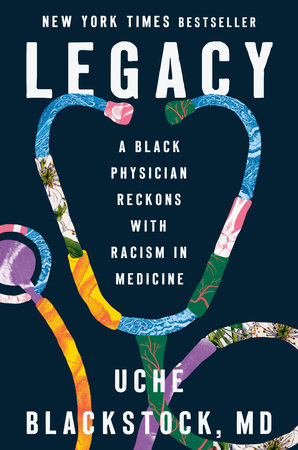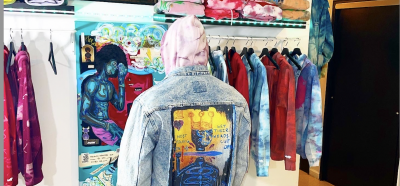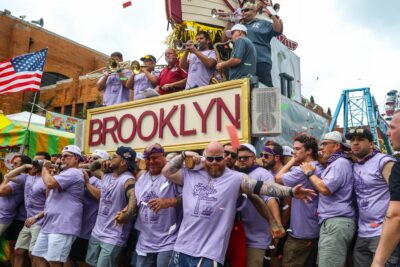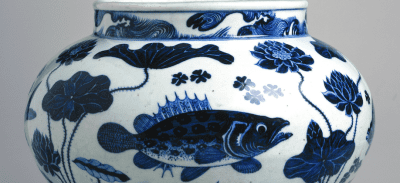Dr. Uché Blackstock (Photo by Diane Zhao, illustration by Johansen Peralta)
Dr. Uché Blackstock’s ‘Legacy’: ‘Our pain is dismissed a lot’
The physician, author and founder of Advancing Health Equity discusses combatting systemic inequity in healthcare
Like what you’re hearing? Subscribe to us at iTunes, check us out on Spotify and hear us on Google, Amazon, Stitcher and TuneIn. This is our RSS feed. Tell a friend!
Dr. Uché Blackstock’s life story is as inspirational and educational as it is unlikely. Not only is Blackstock, along with her twin sister Oni, a second-generation Black woman physician, she is, also along with her sister, the first Black mother-daughter legacy to have graduated from Harvard Medical School.
Today she is the founder and CEO of Advancing Health Equity, a consultancy that helps its clients in the healthcare and corporate spaces to provide racially equitable care. She is also the author of a new book, “Legacy: A Black Physician Reckons With Racism In Medicine,” in which she explores systemic inequity in the American health care system, clearly tracing its origins from slavery and after the Civil War to today — even in her own experiences as a medical student and a doctor.
“While overall, infant mortality rates have gone down, now Black babies are more than twice as likely as white babies to die in their first year of life. There was a narrower gap 15 years before the end of slavery,” says Blackstock, who is this week’s guest on “Brooklyn Magazine: The Podcast.” “And you’re like, ‘Well, there are all of these advances in technology innovation research. Why is this happening?’ It’s happening because racism. That’s why it’s happening.”
A deeply personal and profound book with far-reaching implications for all Americans, “Legacy” is a scathing indictment of our healthcare system, a generational family memoir and a call to action. The book starts with her mother Dale’s story. Dale grew up poor in central Brooklyn, made her way to Harvard Medical School against the systemic odds, became a kidney specialist, working and raising her daughters here in Crown Heights. Sadly she was diagnosed with a rare blood cancer — most likely because of environmental exposures in her neighborhood — and passed away at 47.
Inspired by her mother, Blackstock herself went to Harvard Medical School, and worked as an emergency room doctor early in her career before going into academia. “Legacy “chronicles the obstacles, prejudices, biases and ignorance she often faced as a student, a physician and academic. She left academia to be able to speak more freely about what she had learned about health care in America, including her own stint in urgent care in Bed-Stuy during the onset of the pandemic.
The following is a transcript of our conversation, which airs as an episode of “Brooklyn Magazine: The Podcast,” edited for clarity. Listen in the player above or wherever you get your podcasts.
 This is an incredible book. It should be taught in med schools. Have you thought about that yet?
This is an incredible book. It should be taught in med schools. Have you thought about that yet?
Of course. I think it should be like a freshman read just because there’s so much about the book that every college student should know about, not just pre-meds.
For sure, and anyone going into the workplace, honestly, any grad-level management book. It’s great. It’s so deft at telling a personal story, actually a few personal stories, and putting individual faces on some of these gigantic hidden structural problems deeply baked into American healthcare industry specifically. It’s also a love letter to your mother. Can you tell our listeners about her, what you want her to be remembered as?
Dr. Dale Blackstock, she was the original Dr. Blackstock. It’s very rare for me to be able to say as a Black woman, I’m a second-generation Black woman physician. But my mom was my role model. And I have a twin sister, Oni, who’s also a physician, and I live in Brooklyn now. I live in Clinton Hill, and my mom grew up about 15 minutes from where I am right now in very different situations, on public assistance, to a single mom. First person in her family to go to college, went to Brooklyn College, and had a chemistry professor there who encouraged her to apply to medical school. She ended up at Harvard Med, could have gone anywhere after that, and came back to her neighborhood. Worked at Kings County SUNY Downstate, taking care of essentially her family, friends, and neighbors. I wanted to be just like her. And she was doing a lot of community service work, community health fairs, doing a lot of the work that’s now turned as health equity in the ’80s and ’90s, when it didn’t really have that term, but doing a lot of really wonderful work and service to her community.
And you’ve done a lot to carry the torch since then. We all talk about how representation matters and you can’t be something that you haven’t seen, or it’s at least a lot harder. You had the good fortune to grow up around physicians who were Black, your mother, who was a woman who was Black who looked like you. So not that you were coming necessarily from a point of privilege, per se, but you had the benefit of being able to visualize in a way that other people didn’t necessarily.
Absolutely. And I would say I was privileged. I was super fortunate to see that very early on, and like you said, like my pediatrician was a Black woman, my mom was the president of a local Black woman’s group here in Brooklyn, so I literally grew up thinking that actually most physicians were Black and Black women. It wasn’t until I got older that I realized that wasn’t the case.
Your mother passed away when you were 19. She was very young. She was 47. You’re in college, and you somehow have the presence of mind and the courage, I think it takes both, to ask her, “What are some of the things I should know for the future, things that we won’t be able to discuss later?” Because this is before your real awakening once you’re in the industry and working as a professional. What made you ask that, and what did you take away from that?
It was just such a really difficult time. My mom was a super healthy woman. She ran road races, she’s a member of the New York Road Runners club, and so it was a real shock when she was diagnosed with acute myelogenous leukemia. And I knew we had a short amount of time with her just because her prognosis was so poor, so I summoned up the strength in me to ask her, “What are the things I should know?” and one of the things she told me is, “Make sure you take care of yourself.”
I have to say, as a 19-year-old, I was like, “Okay, all right.” But now, as a 46-year-old, I’m actually the age my mom was when she was diagnosed, and I have all these roles. I’m a parent, I’m a founder and CEO, I’m now an author. Now that I get it and I’ve been through all that I’ve been through in my career, I totally get that point that she was trying to make. It was, “You really got to take care of yourself because it’s really rough out there.” But I think as a 19-year-old, I couldn’t see my mother in all the fullness that she was. I basically just saw her as my mom. Now reflecting back in all the roles that she carried with her, I absolutely get it.
She was a very healthy woman, but it’s a way to put another face on environmental stresses. We talk about “weathering” now and the stress that people under certain circumstances live with, especially people who are marginalized. It ages them internally, and you think that the stress that she grew up with may have contributed to her illness down the line.
The kind of leukemia that my mom was diagnosed with is very rare, especially for a Black woman. Usually, older white men are diagnosed with it. And when we got a second opinion for her at Dana-Farber Institute, the cancer center in Boston, and her oncologist looked at her chromosomes, he said, “It looks like you may have been exposed to radiation at some point in your life.” And when I was doing a lot of the research for the book, I found that my mom lived near Superfund sites. There was toxic dumping. She was moving around a lot, lived in a lot of neighborhoods that were impoverished in Brooklyn. Then, also, this idea of my mom growing up in poverty and just all of the barriers that she had to overcome is incredibly stressful. We know that there’s the term called weathering that essentially espouses that if you are dealing with the chronic stress of everyday racism, that causes a wear and tear on your body, that prematurely ages you and makes you more susceptible.
At the cellular level.
That’s the crazy part. It’s important that we differentiate race as a social construct. There’s nothing biological or genetic about it, but racism can enact forces on our bodies that actually changes our bodies on a DNA cellular level.
The book is one of the clearest explainers I’ve ever read about how some of these structural inequities came to be and how they still play out to this day. We have everything from the Flexner Report, which I had never heard of, to the Tuskegee experiments, Dr. J. Marion Sims, Henrietta Lacks. You connect redlining to the decimation of health in certain communities. We learn how and why the mortality rates for infants and Black birthing people is outrageously high, life expectancy shorter. The pandemic threw a lot of these disparities into high relief. I don’t think I’ve seen a clearer line drawn from a point A and a point B before, which I’m guessing is a big point of the book.
That’s a huge point, and I also want people to understand this was a journey for me in terms of unlearning and relearning and recognizing the gaps in my education and training, and so there’s some things I noticed as a practicing physician, and so that’s why I was like, “If this is what I didn’t know and I noticed, I really have to help the readers understand just from a historical perspective, from even a current-day perspective, why in 2024, we’re seeing these appalling statistics in Black communities in terms of health outcomes.”
As you were researching and uncovered some of these historical facts, what was one that really took you back?
The one that really whenever I say it really upsets me is that the Black-white infant mortality gap in terms of Black babies dying in their first year of life is actually wider now. The disparity is wider now than it was 15 years before the end of slavery. And so while overall, infant mortality rates have gone down, now Black babies are more than twice as likely as white babies to die in their first year of life. There was a narrower gap 15 years before the end of slavery.
That’s crazy.
I know. And you’re like, “Well, there are all of these advances in technology innovation research. Why is this happening?” It’s happening because racism. That’s why it’s happening.
It’s “easy” to say racism because it’s this amorphous thing, but you do connect it to real policies and historical events that are still unfolding.
Absolutely. Even redlining. I didn’t realize I had grown up in a redline neighborhood in Brooklyn. You know, I talk about in the book about my parents having a hard time getting a mortgage to buy our house in Crown Heights because it was a formerly redlined neighborhood. This is the 1970s.
And this is the government literally drawing a red line around neighborhoods saying, “These are risky loans to make.”
You can’t get a federally-backed mortgage or mortgage insurance if you live in this neighborhood. I didn’t realize that neighborhoods that were formerly redlined — this is until I was a practicing physician — are the same neighborhoods with the very worst health outcomes today. The highest maternal mortality rates, infant mortality, asthma rates, it actually maps on the redline neighborhoods. And people will be like, “Well, why is that?” It’s because when you have a neighborhood that’s chronically disinvested in, that actually impacts the health of people who live there.
There’s a lot to take in in this book. There are also some positives throughout. You highlight advances due to Black and non-white contributions, like the development of paramedicine.
I thought that history was really important to share about how paramedicine came about, and of course, it came about from civil unrest. Of course, it came about because Black people were not being appropriately taken to the hospital in a short period of time.
And paramedicine, for the audience, is actually having people on the ambulance who can provide healthcare or emergency health services, which feels like a no-brainer in this day and age, but was a breakthrough at one point.
Oh, yeah, huge breakthrough.
Your book charts your journey through med school to becoming an ER doc, which is not something you anticipated going into. You came to think of it as a place where you could have the most impact on the most vulnerable population, which is probably true, but you write that it’s also a place where you saw the country’s social problems coming home to roost. I think that is most starkly brought to light at NYU, which literally played out this haves and have-nots on the same corner. You have the private Tisch emergency room on one corner, and down the street, you’ve got Bellevue’s emergency room, two buildings there to ostensibly serve the same purpose, but the day-to-day plays out in shockingly different ways. That stark contrast right there in front of us is so interesting to me.
That was another awakening for me, working at both ERs but seeing essentially a two-tiered system and also seeing just a completely different set of resources at one hospital versus the other. At the public hospital, where the patients actually needed to have follow-up and needed specialty care and all of these unmet needs, they just didn’t have that at Bellevue. Whereas at Tisch, you came in, people were like hyper-connected to all of their specialists. There were enough social workers. We were even told we had to dress up when we were at Tisch. We couldn’t wear scrubs. And there’s even this unspoken rule about bringing patients who are unhoused or intoxicated only to Bellevue and not to Tisch because you don’t want to make the other patients feel uncomfortable at Tisch.
This sort of structural racism that you described comes in several flavors. It comes in terms of the care afforded to Black people, but you’re also facing racism as a doctor who happens to be a Black woman. You experience it as a patient yourself while you’re a student at Harvard Medical School. You had appendicitis that was initially misdiagnosed. You’re not listened to, you’re not taken seriously even though you’re a medical student. Talk about that. Was that a galvanizing experience?
At the moment, it wasn’t. Reflecting on it, it was. First-year medical student. I got really bad abdominal pain. I ended up having to go to the ER three times over the course of a week, and it was only at my last visit, once my appendix had ruptured, that I was appropriately diagnosed. But during those visits, I was repeatedly questioned about my sexual activity as if I wasn’t believed. I was told I didn’t seem to be in that much pain. That’s another issue that we often see with Black patients: our pain is minimized and dismissed a lot.
So I always wonder, looking back on that, if I wasn’t a young Black woman, would the diagnosis have been different? I ended up having complications afterwards that led me to miss a month of medical school. But it was really looking back on that experience that I was like, “Oh, wow. Could it have been? Maybe, maybe, probably.”
That comes up time and again. When you’re talking about pain, it made me think about sickle cell anemia, which is obviously a devastating illness that is under-researched, underfunded, under-understood, and it disproportionately affects these marginalized communities. Can you talk about that as when you were in the ER, you had people who couldn’t afford healthcare who would come when they were sick and they were treated dismissively? I wonder if you can talk about that a little bit.
So that was a revelatory moment for me in residency, where I was seeing so many patients with sickle cell disease in the ER. I’m like, “Why am I seeing so many of them?” It’s an inherited disease that afflicts people from actually all over the world. But the fact is that most people in the United States that have sickle cell disease are Black. So it’s been racialized as a Black disease even though it affects people who are Mediterranean, people from India, as well as Sub-Saharan Africa. But even though it’s the first described over a hundred years ago, because it’s been racialized as a Black disease, it’s been underfunded, under-researched. There are very few therapeutics for it. There’s no centers of excellence for sickle cell disease. So that’s why we see a lot of these patients in the ER versus patients who have hemophilia or cystic fibrosis, which afflict people that are racialized more as white. But what happens is when they come to the ER, they get stigmatized as drug seekers. It’s another insult. So there’s a systemic insult, and then there’s this interpersonal insult when they come to the ER where they are not believed to be in pain, and they’re questioned, and they’re not given the pain medication. That actually influenced how I was trained as well.
How did it influence how you were trained? I mean, it’s interesting because, it’s shocking to me that people, medical professionals think, “Oh, they’re just here for a quick hit.” I’m guessing that probably does happen, too, but isn’t the first rule “do no harm”?
Yes, you would think. It is “do no harm,” and my senior residents and attending physicians would say, “Make sure you send a hemoglobin screen to confirm that patient actually has sickle cell disease,” or, “Look at their heart rate or their blood pressure.” But also, pain is subjective. I’m not going to use these other objective findings. So it’s kind of like, the way I was trained sometimes is to be more suspicious of them.
That’s interesting because the myth, of course, is that medicine is unbiased, it’s scientific, it’s fact. You’re rolling your eyes as I’m saying this. Looking back now, you even said earlier in this conversation that there were some stunning omissions in your own medical education. I guess unpack that a little bit for me because it’s medicine, it’s science.
One of the examples I use is just this idea of even kidney function. For a long time, I was taught, even in medical school, that there is a different set of normal values for kidney function for Black patients and non-Black patients, and that this was actually based on this notion, this actually myth that Black patients had more muscle mass, and that translated into the values that are used for kidney function. But what actually that led to is Black people being denied specialty care for kidney failure and delayed placement on kidney transplant list.
This is something you learned in school, as late as that?
Actually, a lot of hospitals still use those normal values, and the National Kidney Association, because of advocacy by mostly Black physicians, recently issued a statement saying, “We encourage hospitals to address this and just have one set of normal values because it actually has caused a lot of harm.” But that was based on this idea that Black people had more muscle.
The irony is, of course, that your mom was a nephrologist in her own right.
Yeah, she was a kidney doctor, and even though it’s one of the most challenging specialties, I still don’t understand very well how the kidney works. I know she wanted to practice nephrology because so many of her patients in her communities were afflicted with kidney disease.
Eventually you go into academia, which you also end up leaving out of frustration. What were some of your experiences? You thought you would be there forever.
I thought I would be there forever, and I think like so many doctors and people who become doctors, we end up checking off boxes. We’re like, “Okay, got that done, got that done.” I thought I was doing important work, and then I actually got appointed to this [diversity and inclusion] role, which turns out was really just a figurehead role. They actually didn’t want me to do anything in the role, and it was really demoralizing actually. I was so excited.
You had been there for a while, and you developed this coursework ultrasound.
I was so excited.
And so they bring you on to head up diversity and inclusion initiatives. And I’ve seen this at organizations where it’s like, “Okay,” talking about checking boxes, like, “We’ve got someone.”
The ultimate checked box, yes.
What would you have liked to have been able to do that you were unable to do there?
I would’ve loved to have been able to actually really focus on efforts around recruitment retention of Black students and faculty in a way that was intentional where I felt empowered to do so. But I actually found out it was sort of just, like I said, a figurehead position, and I actually became scared to speak out about things. I literally was worried that there would be retaliation for me talking about my students who were going through different experiences where they felt like teachers or instructors were targeting them because of their advocacy work. It ended up being a radicalizing moment for me where I said, “I’m kind of being silenced.” I was basically told, “You’re just here really to pacify the students. We really don’t want you speaking up about issues about lack of Black faculty, lack of Black students. I kind of just want you to be quiet.”
“Don’t do the thing that we’re actually asking you to represent.” And so this is when you start phasing out and you start Advancing Health Equity or you start the germ of what that becomes. And during the pandemic, you yourself, much like your mother in some ways, came back to the community. You’re working in an urgent care clinic in Bed-Stuy not far from where you grew up. It was supposed to be a mellow stop gap while you’re getting your consulting company together. Not so much. How was that? You were at the front lines there.
I had left academic medicine. I was like, “I’m going to work part-time urgent care, work other part-time on Advancing Health Equity,” and things were cool, January, February, things were pretty chill. And then March hit. Because of the situation here in New York City, we actually were seeing a lot of Covid patients in urgent care that were too scared to go to the ER. But I started writing about what I saw literally within the first week. My patients became browner, seeing a lot of essential workers, service workers, people who couldn’t work remotely from home, and I actually started writing about it. I was like, “I need to raise the alarm that we’re going to see profound racial health inequities in the pandemic,” so I became one of the first voices in the pandemic to start talking about these issues.
Talk a little bit about the Crown Heights you grew up in. There’ve been a lot of changes, I’m sure, since you were little. That stretch of Franklin Ave. has got to feel somewhat unrecognizable.
It’s almost surreal. I will say that I loved growing up in my neighborhood. It was truly a community. Our neighbors looked out for us. If there was like alternate side street parking and we hadn’t moved the car, someone would come ring the doorbell. If it snowed, our front yard would be shoveled. It was really a great place to grow up, and we were always running up and down the block with our friends. It also was the crack epidemic at the peak of it, and so I’ve seen people get shot. There was a lot of drug activity on Franklin Avenue growing up, and so there were times when Oni and I got off at Franklin Avenue stop, we would actually walk around the long way home down Bedford Avenue just to avoid the drug activity on Franklin Avenue. So I would hear gunshots, we’d find crack files in our front yard. I feel like definitely things are different today. I’m definitely more of a protective parent than my parents were with me, but I was also a latchkey kid, too.
Well, it’s a generational thing as well. And you talk about your mom meeting people who may have addiction issues with compassion.
Absolutely. Like our next-door neighbor partnered up with a woman who obviously was addicted to crack cocaine, and how my mom dealt with her, interacted with her — the respect, the non-judgmental interaction really — I think, influenced Oni and me in just even how we care for our patients.
We’re now four years into this pandemic. Talk about your work with Advancing Health Equity. Who are some of your clients? What are they approaching you about?
In 2020, we got flooded, flooded, flooded. Departments of health, nonprofits that do health-related work, hospital systems, medical schools, other academic institutions. Initially, people were just asking for trainings, but we realized you can’t train away a lot of this. We go in and we do organizational assessments, we do interviews, focus groups, surveys to evaluate workplace culture, we do leadership coaching, and then we also develop strategy planning around equity for healthcare organizations so they’re implementing it into their three, five, 10-year strategic plans. It’s a lot of really cool work.
This is it full time or are you still practicing anywhere?
I just stopped practicing about two-and-a-half years ago in order to run the company full time, but now that the book is out, I’m trying to think about next steps. I think I do want to work more around policy because I find that policy has the biggest impact on communities, whether it’s local, state or federal, and I really would love to find a way to have more influence with policymakers, to really thinking about what health looks like in all policies.
Go back to Harvard and get that Kennedy School degree.
No more school, no more school. I’m done. I’m done.
Being a mother now yourself, the same age your mother was, what do you think about when you look at your boys?
They’re seven and nine. I’m definitely a different kind of mom. My mom was like really, really intense with my sister and me. And obviously, we didn’t do poorly. We did pretty well for ourselves.
You turned out okay.
Yeah, we turned out okay. But my kids, I just kind of want them to have fun, fulfilling lives. I’m not as hardcore as my mom was into academics, but I definitely think about the work that I do with Advancing Health Equity and I want to leave the world a better place for them, so they really drive me to keep doing this work in advocacy.
Are they interested in medicine at all?
Not at all. They’re very unimpressed with me because I’m just mom.
They got to keep it real.
It’s incredibly humbling.
The book ends with a call to action. It’s several calls to action depending on who’s reading it. What’s your own call to action today for our audience, whether they’re in healthcare or not?
Look at what’s happening either hyper-locally or locally in your community. There are a lot of great community-led efforts around health, whether it’s doula services, birthing centers, food sovereignty, housing, and security. I think about all of those types of organizations as doing health-related work. So think about what’s happening in your community, search, and see how you can help support them, whether it’s donating or volunteering.
Check out this episode of “Brooklyn Magazine: The Podcast” for more. Subscribe and listen wherever you get your podcasts.
You might also like 


























